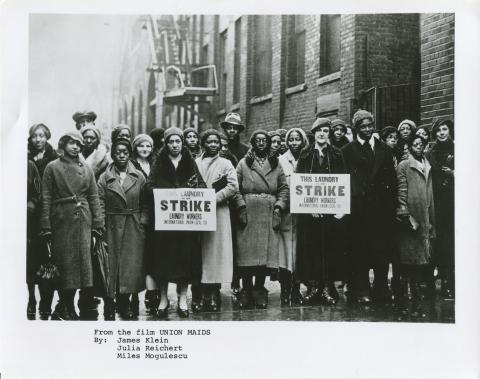UNION MAIDS: Visual Impact for Social Change

UNION MAIDS
This essay on Union Maids (1976), directed by Julia Reichert, Jim Klein, and Miles Mogulescu, was written by Matt St. John, Ph.D candidate in the Department of Communication Arts at UW Madison. Our series of works by Julia Reichert continues this Saturday, November 9 at 7 p.m., followed at 8 p.m. by Reichert's newest film, 9to5: The Story of a Movement . The screenings take place in 4070 Vilas Hall, 821 University Ave. Admission is free.
By Matt St. John
Over nearly fifty years of documentary filmmaking, Julia Reichert has repeatedly returned to the labor movement as a topic. Reichert and her partner Steven Bognar have directed two films about factories in Dayton, Ohio: a 2009 HBO documentary, The Last Truck: Closing of a GM Plant (screening as part of the Cinematheque’s Reichert/Bognar shorts block on November 23), and this year’s American Factory, which follows the complications and clashes when a Chinese company opens a factory with predominantly American workers. Reichert and Bognar’s second 2019 release, 9to5: The Story of a Movement, centers on the forgotten history of an influential women’s labor organization. The films document different situations, but they share Reichert’s attention to the lives of workers, especially as they intersect with issues of gender and race. Reichert first confronted this subject in Union Maids, the 1976 film she co-directed with Jim Klein and Miles Mogulescu.
Her other labor films focus on entire movements or factories, with a few key individuals appearing throughout, but Union Maids highlights the stories of three women in particular. With details of their personal experiences and anecdotes from the many workers they tried to help, Stella, Kate, and Sylvia look back at their time as union organizers in Chicago in the 1930s in interviews that Reichert shot over three days in 1974. In an interview for Alexandra Juhasz’s Women of Vision: Histories in Feminist Film and Video, Reichert recalls that she and her co-directors did not research the topic in great detail before the interviews. In hopes of allowing their subjects some agency in the process, they relied on the women to tell their stories based on their own memories and insights, allowing for intimate conversations that function as engaging portraits as much as oral history. Reichert and Klein, also the film’s editors, later integrated the interviews with an expansive collection of archival photographs and documentary footage they gathered from various institutions, including labor organizations. This compilation style of documentary filmmaking also appears in Reichert’s first two films, Growing Up Female (1971) and Methadone: An American Way of Dealing (1974), although the trove of archival material is even more central here as the subjects in Union Maids tell stories that occurred decades ago.
After shooting her earlier films on 16mm, Reichert and her collaborators chose to shoot Union Maids on video, with the goal of maintaining a low budget. Transferring the video footage to film for distribution was an expensive process, so they ultimately did not save much money. But Reichert found video production liberating, as they could let the women speak extensively without concerns about the high cost of shooting on film. According to Reichert, shooting Union Maids on video also had the unintended effect of a rough, distinct visual style that critics, including Vincent Canby of The New York Times, appreciated in connection with the story’s roots in the left-wing movement.
Moments in Union Maids suggest Reichert’s increasing interest in filmmaking’s artistic possibilities. In the Juhasz interview, Reichert points to a kinetic series of shots that she edited for visual impact alone, rather than any connection with social change: as Sylvia discusses arriving in Chicago, trains run down tracks in different directions. Until this point, style was not a major concern for Reichert. She hesitated to accept the labels of artist or filmmaker, thinking of her films primarily as tools that could be used by progressive organizations. After hoping that Growing Up Female could help organizations start conversations about the oppression of women, she approached Union Maids as a tool that could bring together the women’s movement and the labor movement.
While the film was used by labor organizations, Reichert and her collaborators finally thought of themselves as filmmakers after Union Maids played theatrically in twelve cities across the United States. The film received critical acclaim for its woman-centered perspective on labor history, and it was nominated for Best Documentary Feature at the Academy Awards. Some contemporary leftist critics condemned the film for apparently neglecting the women’s involvement in the Communist Party, but Reichert says the filmmakers remained unaware of the connection until the night of the film’s premiere in Dayton. After hearing Stella, Kate, and Sylvia discuss their experiences as Communists, Julia Reichert and Jim Klein decided that their next film would tell the story of the party in the United States. That project became 1983’s Seeing Red, their second Academy Award-nominated feature, which will screen at Cinematheque on November 16 with Julia Reichert in attendance for a post-film discussion.
